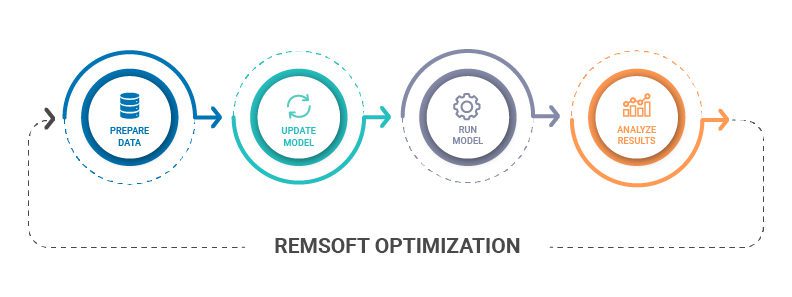Tapping into the value of existing data and analytics has become essential for organizations that need to plan across complex supply chains and manage high volumes of valuable assets. Remsoft has been part of this transformation for more than 29 years, providing technology that delivers data-driven decision support and actionable recommendations. In this article, we explain how Remsoft’s unique approach to optimization modeling can help you make better decisions.
Database and mapping technologies have changed in the last few decades and will no doubt keep changing from time to time, so our modeling and data approach has changed too. For many years, the standard modeling approach was to create a Woodstock model section-by-section using largely manual processes. (Although, the platform does provide options to import data into models from a spatial data source and a limited range of structured data files such as DBF.) This was time-consuming and laborious. For problems that required models to be updated and run frequently, this manual, disconnected approach simply did not work.
We understand the value of our clients’ time and we know that demands on their expertise is always increasing. It can also be challenging for organizations to find qualified, analytical planners. The need for connected forestry planning, integration of large volumes of data, and support for a more efficient and elegant planning process requires a better modeling approach and enhanced connectivity to data. When it comes to building a business solution on the modeling platform, we must look for a more repeatable and self-contained process.
Our current approach combines a standardized database with modeling platform integration managed and executed using a model Template file. This single file bridges the gap between your data source and model and employs scripts to automate the translation of data into model code. This approach automates workflows, saves time, and eliminates errors that can happen with manual processes. With a data-integrated model, you simply update your data source, run the integration scripts and you are ready to perform your analysis.
Now, let’s talk about data. As we explained in another blog post, it’s important to do some conceptual modeling before diving into the technical modeling so you fully understand the problems you are trying to solve. But once the conceptual model is defined, we have to consider what data is needed and in what format.
Remsoft solutions source data from a relational SQL server database with a schema designed to integrate with models. It consists of two databases: a staging database in which clients populate data for the model, and a model database that is used as the model data source. It also has scripts to transfer data from the staging database to the model database, and to validate data quality.

Our years of experience has allowed us to develop a streamlined workflow. This is the path to data integrity and integration with information systems. This standardized approach is fully configurable and adapts to most clients’ problems with only a few weeks of work and is now the norm when delivering optimization solutions. There is a lot of value in establishing a standard input data format.
If you already have a mature model that you have been using for years, you might be wondering if it is still possible to achieve this level of connectiveness. For sure, Remsoft can help you take an existing model, validate its problem frame/decision scope, match it with one of our solutions and deliver a database with a functional Woodstock Template file. It is a little like retrofitting your model but with the added benefit that we will improve usability and apply best modeling practices.
If you are evaluating whether optimization can solve your planning challenges and help you achieve your goals, contact us and we can provide more information.
LEARN MORE:
- Download our Woodstock platform brochure for more information on analytics-based planning with optimization modeling.
- Schedule a free assessment to discover how optimized planning can help you achieve your immediate and long-term objectives.




